|
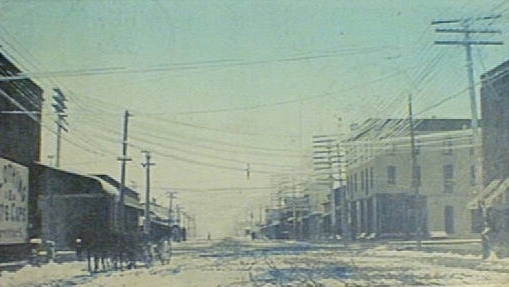
Casper, May 17, 1907
Ah, Spring time in the Rockies! Actually, not all that unusual, but nevertheless,
the weather in the Casper area has been a topic of discussion since at least
1865. The 1865 diary of a Civil War soldier, Elijah Nelson Doughty, on patrol
and camping in the Platte River Valley near present day Casper contains the
following entries:
April 19: Snowing, in camp as usual. We have eat our breakfast. Have tied our
horses out in the brush to browse and shelter from the storms of this
country. It is now getting late and we have brought in our horses to feed
and groom them. We have eat some hard tack and bacon and will soon crawl
in our tents to shelter us from the miserable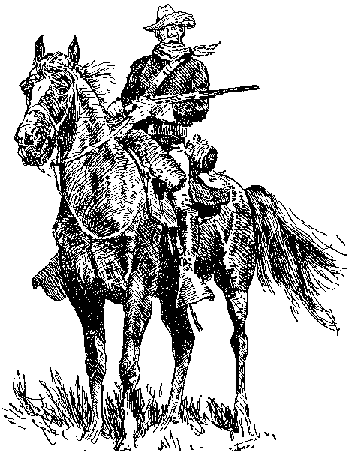 snow storms of this country.
snow storms of this country.
April 20: Got up to roll call and found it still snowing. It has now been
snowing for the last forty eight hours and no prospects of quiting anyways
soon. We have tied our horses in the brush as yesterday. Have eat our
breakfast and are now setting around our fires trying to keep warm. It is
now getting late and the snow fall as usual. Six of our boys started on
a three days hunt this morning.
April 21: Still snowing. One man killed and another wounded by the Indians
12 miles from here while carrying the mail from here to [Fort] Laramie.
The Indians were repulsed by six soldiers. The Indians numbered twenty
or more.
April 29: Remaining in camp. The weather has the appearance of spring.
The grass begins to grow slowly and has the appearance of summer.
May 2: The weather remains like summer. The boys are swimming Deer creek [Webmaster's note:
This would place the camp at present day Glenrock, about 26 miles east of
present day Casper].
The water cold as snow. We have guard mount drill once a day. The boys makes
a skift out of a beef hide and quite a number of the boys has been ducked
by the use of their new skift.
May 4: A.D. 1865: Warmer yet today and lazy weather for shaved heads.
Our boys who was left at Riley came up with the mail party except a few
to wit: B. F. Norton, W. H. Norton, N. H. Norton, Grerry W. C. Haselwood,
S. Barker, J. A. Norton and James Hames. The above named soldiers will be
discharged. the water still keeps up.
May 5: This morning a detachment of thirty men from each Co., of the Regt.
starts to Powder river on a ten day scout to break up some Indian
villages which are said to be out there. It snows and rained here last
night and consequently the weather is quite cold today.
May 9: Snowed last night and is still snowing. We have eat our grub
and again taken refuge in our poor though quite comfortable tents
considered by us at this late hour. It is now night and the snow has
fallen all day and looks like winter.
May 10: The sun shines out brilliant this morning, again assumes the
appearance of summer. The grass went up the spout last night you bet.
The snow is fast melting this nice morning.
As suggested in the diary entries, problems with the Indians were beginning to come
to a head. As related on the
Buffalo Page, later in 1865 the Fetterman massacre occurred with the subsequent withdrawal
of military forces from Fort Kearney. In the area of present day Casper,
as indicated below,
the problem with Indians also arose.
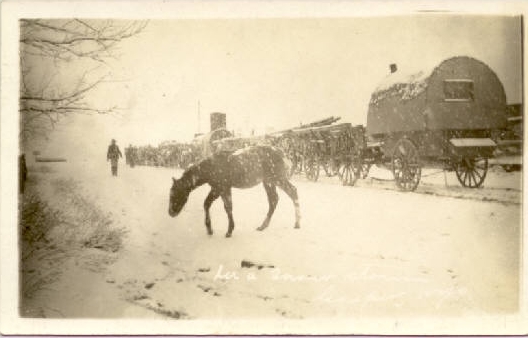
Casper, 1907
In 1865, two battles were fought with the Sioux near present day Casper, one the Battle of the
Platte River Bridge, in which a 20-year old lt. Caspar Collins, was killed, and the
other shortly thereafter the Battle of Red Buttes, when the Sioux attacked
a wagon train coming from Sweetwater Station. Casper is named after Collins. Ft. Collins,
Colorado, is named after Collins' father who was also a military officer. The
reconstruction of Fort Caspar is based on sketches of the fort at the Platte River
Bridge made by Lt. Collins in 1863.
The two battles were described by William G. Cutler in his 1883 History of the
State of Kansas
Cutler sets the scene:The garrison at Platte River Bridge consisted in all of
about one hundred and ten men, including the non-commissioned staff and
band of the Eleventh. About eighty of the number were armed with carbines,
but were now reduced to less than twenty rounds of cartridges per man. Of
the remaining thirty, about half had revolvers, and the others no arms.
The recent demonstrations caused Maj. Anderson grave apprehensions regard to Sergt.
Custard of Company H, who, with twenty-four men of Companies D and H, had
been to South Pass, as escort to a train with supplies for the various
stations, and was now within about twenty-five miles of the station on his
return. On the morning of the 22d, the party came in view on a high hill
about six miles west, apparently unconscious of the presence of Indians
in their vicinity.
Cutler describes the Battle of the Platte River Bridge and the death of
Caspar Collins: The howitzer was fired to warn them of their danger, and Lieut. Collins
with about thirty of the best mounted and armed men of the Eleventh, sent
to their assistance. The Indians remained in ambush until the party from
the station had moved out about half a mile to the first range of bluffs,
when suddenly from the ravines, and woods, and every conceivable hiding
place, 2,000 Indians sprang into view and charged upon the little band
from every direction. There was no hope of going forward, and seemingly
no chance of escape; but after once discharging their carbines, which they
had no time to reload, with no weapons but their revolvers, they fought
their way back toward the station. The party was completely surrounded on
every side, and friend and foe so intermingled in the confused mass of
combatants, that Maj. Anderson was unable to use the howitzer, but all
the remaining available force of his already weak garrison was sent to
the relief of the sorely pressed party. The Indians now turning a portion
of their force against the new enemy, Lieut. Collins' party succeeded in
cutting their way through the host that still beset them, when just as
escape seemed possible, and the worst was apparently over, Lieut. Collins'
horse, maddened by the terrible confusion, broke from the control of his
rider, carrying him straight into the surging crowd of eager, vengeful
savages, to share the fate that befalls every unfortunate foe that falls
into their cruel hands. Of the party, four others were killed, and one
wounded. The rest, as by a miracle, escaped.
Cutler describes the Battle of Red Buttes: Sergt. Custard had, in the
meantime, nearly gained the river, and saw the Indians for the first time,
when the whole host rushed upon him, after their encounter with Lieut.
Collins' party. The men sheltered themselves as best they could behind
their horses until they were shot, and then taking advantage of every
knoll and hillock, for six hours fought with the desperate courage of men
who feared the death of a soldier far less than the horrible fate of a
prisoner. Every one was slain; only three men of the party who were cut
off before the fight began, and who escaped by swimming the Platte, lived
to carry the tale to their sorrowing comrades at the station. The next day,
when the mutilated bodies were recovered, and buried, with military honors
in one grave, every Indian had disappeared from the vicinity, and was
beyond the reach of any punishment which the garrison might be able to
inflict.
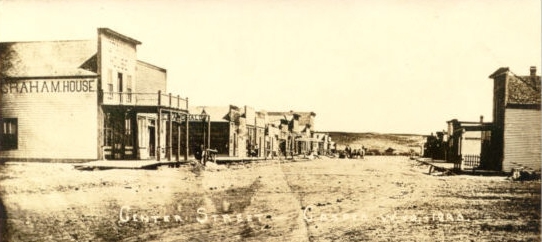
Center Street, Casper, 1890
Compare the above photo with the one immediately below.
The board sidewalks have been replaced, street lights installed, and crosswalks on the
side streets have been built so pedestrians will not have to walk in the mud.
The false fronted hotel on the left is still in existence below but has changed its
name. The Courthouse has been built in the photo below.
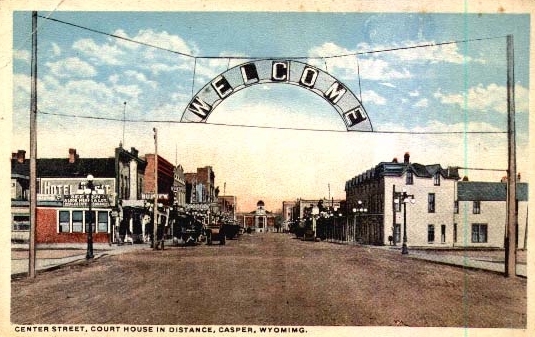
Center Street, Casper
The building to the right with the dormers is the Hotel Natrona, J. P. Smith, proprietor.
Casper as a city dates to 1888 when Joseph Maull Carey (1845-1924) designated a part of
his C Y Ranch as the townsite. The C Y was the first ranch in the area constructed in 1876 when
Carey trailed 12,000 head of cattle up from Austin, Texas. CY Avenue in Casper is named after the
ranch. 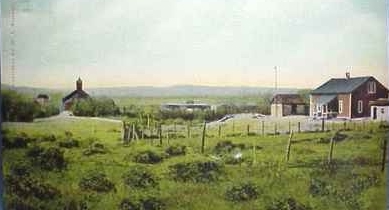 C Y-Early-Day Ranch, undated
C Y-Early-Day Ranch, undated
As indicated above, Casper was the site of the Platte River Bridge built by
Louis Guinard in 1859-1860 replacing an earlier bridge down stream which had
washed away. The bridge was 810 feet long and was supported by 28 wooden cribbens.
Total cost of the bridge was approximately $40,000. Tolls, depending on the
flood stage, varied from $1.00 to $6.00 per wagon. Before the construction of the bridge the
area was the site of several ferrys, including the Mormon Ferry. The ferry
was guided across the river on a cable. The ferrymen could by varying the angle of the
craft cause the river current to propel the vessel across the river in either direction.
Upon the formation of Natrona County in 1889, Casper and Bessimer vied in an election to
become the county seat. Bessimer is now a ghost town.
The first refinery opened in 1895. In the 1980 census Casper surpassed Cheyenne
as the State's largest City with a population of 51,000.
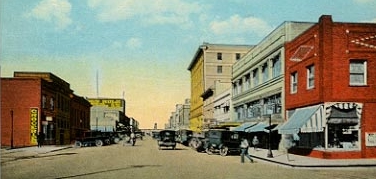 Second Street, undated
Second Street, undated
J. M. Carey came to Wyoming upon his appointment as District Attorney by President
Grant in recognition of his services in Grant's presidential campaign. Subsequently he became
an associate justice of the Wyoming Supreme Court. He thereafter retained the title of
"judge" throughout the rest of his life notwithstanding his election as United States senator as a Republican in 1890
and
governor as a Democrat in 1911. He also was one of the organizers of T.
Roosevelt's Progressive Party in 1912. Judge Carey also served as mayor of Cheyenne, territorial delegate to Congress and was
the author of the bill granting statehood to the territory. During the debate over
statehood he claimed that Wyoming had a population of over 110,000. The population estimate
was able to persuade the winning margin for the bill in the House of Representatives. The
following year the U. S. census revealed that the actual population was somewhat less--62,555.
Judge Carey was a founder of the Wyoming Stock Growers Association and the Cheyenne Club. Ultimately, he
turned management of the family business, J. M. Carey and Brother Cattle Growers, over to his son
Robert D. Carey (1878-1937) who followed in his father's footsteps serving also as both governor and United
States Senator 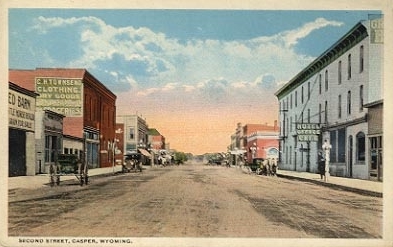 Second Street, undated
Second Street, undated
Following the Fetterman Massacre, John "Portugee" Phillips (1832-1883),
a civilian, was dispatched 190 miles to Horseshoe Station, near present day Glendo,
the site of the closest telegraph.
Perservering through blizzards, he arrived and managed to
send the message to Ft. Laramie and Army headquarters in Omaha before the Indians
burned the station. He then continued his journey through yet another blizzard and finally arrived in Ft. Laramie
on Christmas Eve. As he entered the confines of the fort his horse dropped dead. Phillips, himself,
was required to recouperate in the post hospital for two weeks.
Because of delays in paper work related to his American citizenship, no Army recognition was
given of his feat. In 1899, the Wyoming Legislature posthumously awarded him
$5,000.00 which was presented to his widow. [Webmaster's note: Historians for
the National Park Service have been unable to find a contemporaneous report of
the death of Phillips' horse. This is not surprising, especially considering that
other documents relating to the incident have been lost, including Col. Wessels'
message to Col. Innes N. Palmer, commander at Ft. Laramie.
In light of the other problems with which the Army had to deal, it
is doubtful that the telegrah wires to Omaha would be burning up with the
details of the demise of the animal. Palmer, for his services in the Civil War, bore the rank of
Brevet Major General. Wessels, commander at Fort Reno, also had a Civil War rank of
Brig. General. Thus, as George Armstrong Custer is often referred to as "General," even though
his actual rank was Lt. Colonel, Wessels and Palmer are frequently referenced with their
brevet rank of general.]
North Platte Photos continued on next page.
|